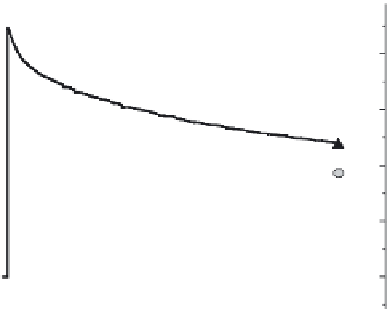Environmental Engineering Reference
In-Depth Information
FIGURE 2.21
High-resolution transmission electron microscopy of PtRu nanoparticles deposited inside 2PSC carbon. Black
spots are the high-contrast (large atomic number) metal, while the amorphous structure is carbon.
400
200
PtRu (nanoparticles) on 1PSC
300
150
200
100
Commercial catalyst
100
50
0
0
0
100
200
300
400
500 00
700
Time (s)
FIGURE 2.22
Current transients for methanol electrooxidation on PtRu/1PSC at 0.55 V
RHE
, 1 M CH
3
OH + 1 M H
2
SO
4
.
T
= 60°C.
Gray circle, mass activity for a commercial catalyst (PtRu on E-TEK
®
) in the same conditions.
value obtained for a commercial PtRu on C in a similar condition of analysis. As it can be
seen, the mass current density is clearly larger. While methanol is toxic, it is less likely to
be found in wastewater contaminated with organics. However, PtRu catalysts have shown
to be able to oxidize other organic compounds that can be present in wastewater [163].
2.4.4 Absorption of Water Organic Contaminants into
Hydrogels and Nanocomposites
It has been shown that the partition coeficient of different solutes depends on the chemi-
cal structure of the hydrogel monomer unit, the chemical structure of the solute, and the
presence of a loaded conducting polymer. The polymer chains are more hydrophobic than
the water illing the pores or the external solution. Therefore, organic contaminants will
preferentially partition inside the hydrogels. Such properties can be used with proit to
remove toxic organics in the presence of other solutes. In Figure 2.23, it is shown how a dye





